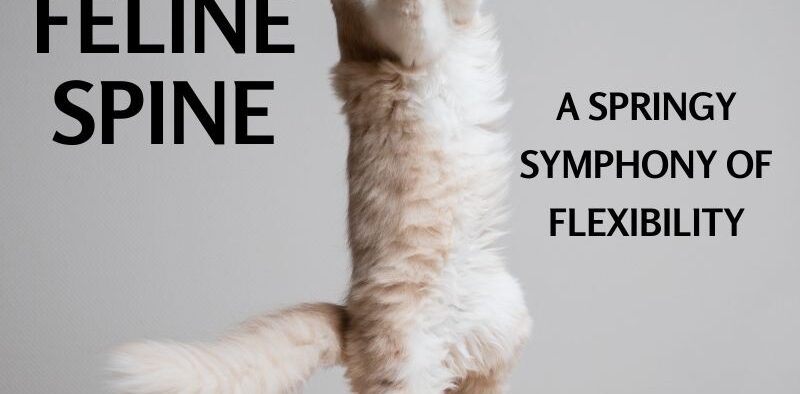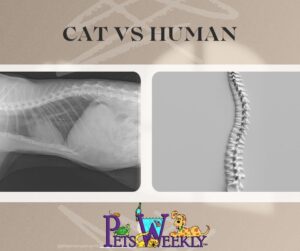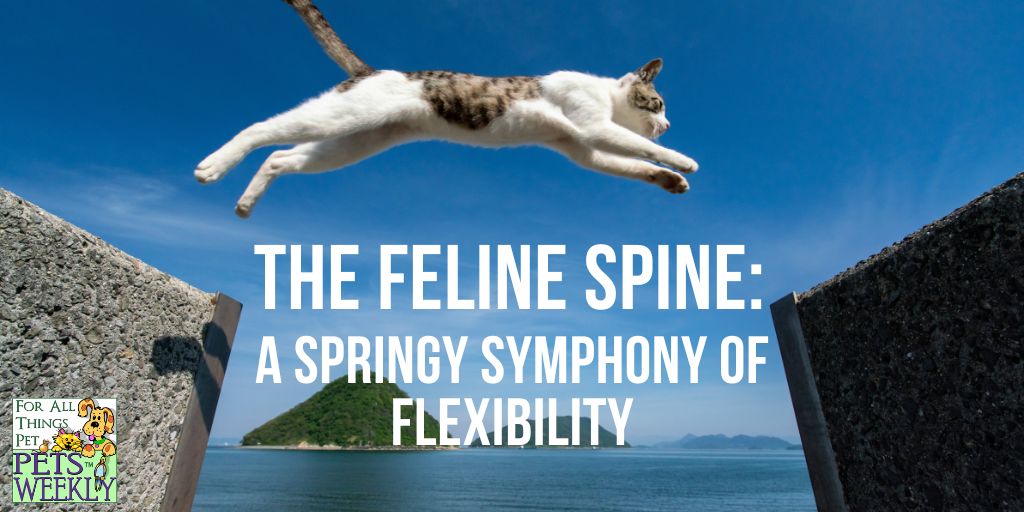The Feline Spine: A Springy Symphony of Flexibility
Share

While Direct Registering steals the spotlight in feline locomotion, the true conductor of this graceful ballet is the cat’s spine. Unlike our stiff, relatively immobile backbones (which I’m sure a lot of you can relate to), the feline spine is a marvel of flexibility. They are a springy symphony of bones and cartilage that allows for contortions and leaps that would leave most humans groaning in envy.
Let’s delve deeper into the secrets of this remarkable structure and explore how it fuels the feline footfall.
The Building Blocks of Bendy: Unveiling the Feline Vertebrae
The first difference lies in the sheer number of vertebrae that cats have. Humans have a mere 33 vertebrae (all of which seem mostly problematic to most of us), while cats boast a whopping 53 vertebrae!

Each one of these vertebrae create a tiny building block of their flexible backbone. These vertebrae are shorter and lighter than ours, allowing them to move more freely and independently.
The surfaces of the vertebrae themselves also contribute to the flexibility. Unlike the flat, smooth surfaces of human vertebrae, the feline joints have angled facets that fit together like puzzle pieces. These facets allow for a wider range of motion in multiple planes, enabling the spine to bend, twist, and rotate with unparalleled ease. Imagine a hinge with a wider range of movement than just back and forth – that’s the essence of the feline facet, unlocking a world of contortions and agility.
But the story doesn’t end with the number of vertebrae. Between each bone lies a crucial player – the intervertebral disc.
The Intervertebral Disc: Elasticity and Cusioning
These discs, unlike ours, are packed with extra elastic cartilage, acting as shock absorbers and providing additional cushioning. Could you imagine what we could do with the same cusioning?
Think of them as miniature trampolines, allowing the vertebrae to twist and turn without grinding against each other or causing pain. This extra elasticity is what allows cats to contort their bodies into impossible shapes, squeezing through tight spaces and landing on their feet from dizzying heights.
Imagine a springy willow branch compared to a sturdy oak – that’s the contrast between our spines and theirs. This bounty of bones allows for unmatched agility and contortions, letting them twist and turn with the grace of a ballerina and the precision of a gymnast.
Nucleous Pulposus: Nature’s Shock Absorbers
Between each vertebra lies a hidden treasure – cushioning elastic discs filled with a gel-like substance (called the nucleus pulposus). These squishy cushions act as supercharged shock absorbers, smoothing out every twist and jump, protecting their delicate bones from the impact of gravity-defying leaps.
Picture a stack of “connected on one” end poker chips versus a stack of “connected on one end” dominoes – the feline spine is the domino stack, offering more points of articulation and greater freedom of movement.
The difference between them is huge. Imagine bouncing on a trampoline compared to landing on a concrete floor – that’s the difference these discs make. The feline spine’s flexibility isn’t confined to its own domain. It extends its influence to other parts of the body as well.
The shoulder blades, for example, are loosely attached to the spine by muscles instead of bone, allowing them to move independently and contribute to the overall agility. This loose connection also allows for the feline’s impressive stride, where the front and back legs move in unison, maximizing their reach and propelling them forward with effortless grace.
A Tail for Balance…
The feline spine doesn’t stop at the base of the body. Their furry appendage is an extension of the spine itself, adding another 20-23 vertebrae to the equation. Their flexible tail acts as a counterbalance, providing crucial stability during those daring jumps and lightning-fast sprints. Think of it as a furry rudder, guiding their movements with precision and ensuring they always land on their feet.

The Muscles of Maneuver: Powering the Feline Spine
A network of powerful muscles surrounds the spine, providing the force and control needed for those impressive leaps and twists. These muscles, constantly adjusting and contracting, fine-tune the movements of each vertebra, allowing for precise control and delicate balance even in the most challenging maneuvers. Imagine a team of acrobats working in perfect harmony – that’s the feline musculature, working in concert with the spine to create a masterpiece of movement.
A network of powerful muscles surrounds and connects the spine, acting like invisible puppeteers pulling the strings. These muscles provide the dynamic force for all those incredible feats, allowing cats to launch themselves into the air, squeeze through impossibly narrow spaces, and contort their bodies into pretzel-like shapes. Imagine a gymnast with extra limbs, each one controlled by a skilled trainer – that’s the power of feline muscles.
The Result: A Symphony of Movement
This intricate combination of flexible bones, shock-absorbing discs, a balancing tail, and powerful muscles unlocks a symphony of movement unmatched in the animal kingdom. It allows cats to:
- Twist and turn their bodies 180 degrees: Imagine swiveling your head all the way around without moving your body – that’s a feline feat!
- Jump incredible heights: Their spine compresses and releases, propelling them into the air like a coiled spring.
- Land on their feet: The flexibility of the spine allows them to adjust mid-air and absorb the impact, ensuring a graceful (and often comical) landing.
- Navigate tight spaces: Their spines bend and contort, allowing them to squeeze through the tiniest of gaps, much to our amusement (or frustration).
This flexible spine isn’t just about parlor tricks and acrobatics. It’s a vital tool for survival, allowing cats to stalk prey silently, chase with agility, and escape danger with lightning-fast reflexes. The flexibility also helps them absorb shocks and falls, protecting them from injury.
A Testament to Evolution: How a Cat’s Spine has Evolved
The feline spine is a masterpiece of evolution, each facet finely tuned to their diverse environments. It’s a testament to the power of adaptation, allowing these creatures to thrive and become the graceful, agile, and mischievous masters of movement that they are. The feline spine’s flexibility isn’t just a party trick. It offers several crucial benefits:
- Predatory Prowess: The ability to contort their bodies and move silently allows cats to stalk prey with unmatched stealth and surprise their victims from unexpected angles.
- Escape Artistry: Tight spaces become playgrounds for cats, their flexible spines allowing them to squeeze through seemingly impossible gaps and evade predators.
- Acrobatic Ability: From leaping onto high shelves to navigating furniture with ease, the feline spine fuels their impressive athleticism and playful antics.
- Landing on Their Feet: The flexibility of the spine allows cats to absorb impact and adjust their posture mid-air, ensuring a safe landing even from great heights.
- A Testament of Adaptation: We’ve discussed the history of development in our preferred predator, but their long history of adaptation is important to understanding their behavior.
A Final Note on The Feline Spine
The feline spine is a masterpiece of evolution, a testament to the power of adaptation. It’s a springy symphony of bones, cartilage, and muscles that allows our furry friends to move with grace, agility, and an almost supernatural flexibility.
So, the next time you witness your cat’s gravity-defying leaps or marvel at their contortions, remember the hidden wonder of their spine – the secret weapon that unlocks their incredible agility and allows them to paint the world in their own unique, paw-print-filled ballet.











